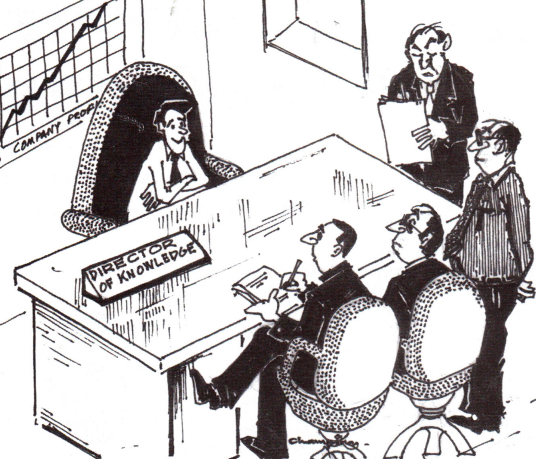by Sam Swaminathan
Everyone knows that business runs on brains yet, how many companies do anything to nurture them?

Sam Swaminathan is a Soft skills Management expert, trainer, speaker, and consultant. He regularly writes management articles to The Khaleej Times, The Economic Times and The Dalal Street Journal. Sam Swaminathan is also the Founding Director of the Centre for Creative Thinking, Dubai
Leif Edvinsson has an unusual job title – Director of Intellectual Capital. Is this yet another smart trick to side track executives who corporations want to get rid of, yet are unable to? Wait a minute, here’s another one Director of Intellectual Asset Management. And another – Director of Knowledge. All these positions are at Director level, not supervisor, head, or manager levels.
No, I didn’t drum up these titles from out of nowhere. They actually belong to real people who work for real corporations like Skandia, Dow Chemicals, and McKinsey.
What do these people do? They are the new age workers, pushing at the cutting edge of corporate management, doing jobs that will baffle bean counters and butchers alike. Put simply, they are making ground breaking efforts to identify, encourage, and measure the most valuable asset of their organizations collective knowledge.
When Microsoft’s stock market value with a turnover of US$ 2 billion overtakes that of General Motors with a turnover of US$ 124 billion (1992); when a strategic planner from 3M states that they are trying to sell more and more intellect, and less and less material; when the New York Times reports that Microsoft’s only factory asset is human imagination; when a Tom Peters seminar slide reads Real men don’t bend metal any more; you do begin to listen to the guy who says, “Man, if you can touch it, it ain’t real!” It is time then to sit up and wonder whether those guys from Skandia, Dow, and McKinsey are bananas after all.
This isn’t all. A recent issue of Fortune carries a report that corporate knowledge appears in the shape of wisdom, experience, and stories not dollars and dimes. To capitalize this knowledge, Hughes Space and Communications has just begun a pilot project to connect existing lessons learned databases, using Lotus Notes. The purpose to keep track of the folks who remember the recipe, and nurture the technology and culture that will get them talking.
Knowledge is becoming more important for another reason as well the constant shift of customer preferences forcing markets to embrace greater customization. Customization pivots around knowledge-knowledge of products, processes, customers, and everything else as well. In fact, knowledge is the most significant input for customization.
Like it or not, “invisible assets” are more valuable than “visible assets”. The contents of a salesman’s brain with in-depth knowledge of his customers is more valuable than the swanky building in which the corporate headquarters is located. Ask any CEO about his/ her company’s assets and he/she will reel off facts like the utilization of showroom space, factory equipment, vans, and trucks. What about knowledge, you ask, and a wall of silence will likely hit you. A Swiss think-tank study reveals that barely 20 percent of knowledge is used in the most intellectual of corporations. Imagine the impact of turning the tap to 30 percent. The competition would simply be blown to bits.
Some years ago, a team from Matsushita was working on their first bread making oven. Several attempts were made to build fuzzy logic into the chip that controlled the baking. Nothing worked. The bread was either too hard or too soft. Until a young girl from the team asked time off to work with the best baker in town. She then spent several months by the baker’s side, watching him knead the dough and bake the bread day after day to perfection. Hardly a word passed between the two. Each day the Matsushita girl would knead the dough and present it to her teacher, who would touch it, shake his head, and carry on with his work. Several weeks of failure and observation later, one fine day she was suddenly able to knead the dough to perfection. For weeks after that, she repeated the success. Her mentor eventually smiled and acknowledged her achievement.

By merely watching and experimenting, the girl caught on the finer aspects of bread making through the process of implicit learning, and then transferred the knowledge to the heart of the Matsushita bread making oven. The oven is the best in the market to this day.
Matsushita’s Director of Learning (if there were one) would make sure that the girl’s learning is transferred to the company’s knowledge database. He would ensure that the girl is given similar opportunities in the future. She would be encouraged to help other employees develop their skills. The Director of Knowledge would be responsible for building roadmaps of knowledge, showing where and in whose heads the knowledge resides. Why? Because, if you lose the recipe, you’ll have to reinvent it. Consequent risk expensive and unforgivable mistakes. Eventual result corporate catastrophe.
Whether your company markets marbles or missiles, knowledge assumes equal importance. Knowledge in individuals’ heads is great. But this resembles isolated islands. Clamp the islands together with a suitable organizational culture, and you’ve got the awesome power of collective knowledge. The brain per buck of your business would have really blossomed.
Whether your company markets marbles or missiles, knowledge assumes equal importance. Knowledge in individuals’ heads is great. But this resembles isolated islands. Clamp the islands together with a suitable organizational culture, and you’ve got the awesome power of collective knowledge.
Such knowledge, properly captured and harnessed, becomes available for ever to everyone in the company. Suddenly you’ll find customers running to you for solutions instead of you running around trying to entice them to buy solutions that do their bottom line no good.
Intellectual capital doesn’t grow in hierarchical structures any more than daffodils grow in deserts. To unleash this capital and leverage it, what is required is a seamless structure founded on the bedrock of mutual trust and respect for the individual. Commenting upon General Motor’s recent turnaround, CEO Jack Smith had this to say about hierarchy- “Size and success led to complacency, myopia, and ultimately, decline.”
Do the instruments in your corporate cockpit measure brains, trust, and respect? No? Then you are flying a Boeing 777 fitted with DC-3 apparatus, and using phones built with two cans connected by a string. Better prepare for a crash landing. Isn’t it about time you ran an ad for a knowledge manager?


